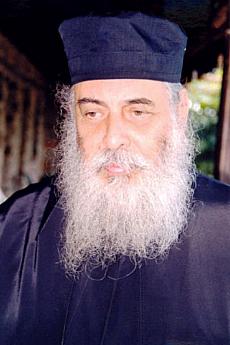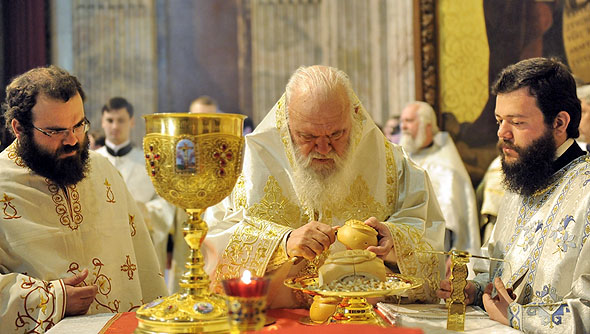People as Liturgical Beings – Part 1
4 August 2016 We usually characterize people as rational and independent beings. These attributes are correct enough, but don’t convey human nature in its completeness.
We usually characterize people as rational and independent beings. These attributes are correct enough, but don’t convey human nature in its completeness.
Through the liturgical experience, we feel that, more than anything, people are liturgical beings. They were made to serve, to offer themselves and the whole world to God with gratitude, praise and worship, to unite with God, to be sanctified, to live, through this continual offering/sacrifice/service.
Rationality, independence and the other attributes were given to us for this reason, so that we can put ourselves into this liturgical relationship with the Triune God. In this liturgical ascent, people act as being ‘in the image’ and are elevated to being ‘in the likeness’.
Life in Paradise was a Divine Liturgy. Together with the angels, Adam and Eve served the Holy Trinity. With the fall into egocentrism they lost the possibility of offering themselves and the world to God in a Eucharistic manner and thus of taking part in the joint ministry in Paradise.
Self-exiled from the Liturgy in Paradise, they found themselves on earth without the function of the Liturgy. ‘The ‘in the image’ was no longer active. Some remnants and sparks from the prelapsarian function of service remained within them. These moved them to build altars and to carry out sacrifices to God.
At best, this worship was fragmentary, a shadow, a type. It didn’t bring people into perfect communion and union with God. It didn’t give us the Holy Spirit. It didn’t save us from death. It did, however, encourage in us the desire for the true Messianic Liturgy. This desire and vision gave hope to the people who were sitting in darkness and the shadow of death.
The Heavenly Father’s love could not leave us without liturgical service. By His providence, the Word was made flesh. Jesus Christ, the Great High Priest, began the joint ministry of the New Testament.
The Liturgy of the New Testament could only have been instituted by Christ, because Christ alone was able to offer Himself and the whole world completely to the Triune God. There were people who sacrificed in the Old Testament, too. There were no sacrificial victims. Jesus Christ was the perfect sacrifice and at the same time the perfect person to perform the sacrifice. The unblemished sacrifice. The Lamb of God Who takes away the sin of the world…
People- and the world- without Liturgical function, being un-liturgized fell into the power of the devil and of death. With His death on the Cross and His Resurrection, Christ redeemed us from this enslavement, liberated us and gave us the chance to take part in the joint ministry of the New Testament. That is, to offer ourselves to God, to thank God and to praise Him. In being offered and offering all things with Christ to God, we serve as people. That is ‘in the image of God’. We become real people.
The Liturgy of the New Testament is greatly superior to the Liturgy in Paradise. Now the High Priest is the Son of God Himself. The Mother of God and the Saints concelebrate and together praise the All-Holy Trinity ‘with ceaseless mouths and unflagging praises’.
Every baptized Orthodox Christian who dies in order to live takes part in this joint ministry. In this shared Liturgy people find their true nature and their true repose, their real ‘in the image of God’ self. Outside this shared Liturgy, people may be Homo Sapiens or Homo Economicus of the Socialist or Capitalist society, but not the rulers of creation, not the tipping point between the created and uncreated world and ‘in the image of God’.
The Divine Liturgy of the New Testament began with the incarnation of the Word and is continued into the far future by the Great High Priest. Every Divine Liturgy celebrated at the altars on earth is a participation in time in this timeless, everlasting Liturgy. ‘We sinners also cry aloud with the Blessed Powers, Master and Lover of Humankind, and say: ‘Holy You are and Most Holy…’.
Every Priest and Bishop who celebrates at the earthly altars ‘performs the priestly function of Christ in the Church’ (canon of Carthage). He doesn’t have his own priesthood. He takes part in the unique Priesthood of Christ.
Our greatest sin today is that we don’t have a Liturgical function. We don’t offer and aren’t offered to God and to our fellow human beings.
It was once considered an insult to say that somebody was ‘un-liturgized’. Today, however, because of our unbelief and hardness of heart, it’s considered natural, whereas it’s unnatural and weird for people to exercise a Liturgical function.
Even when people today ‘go to church’, it’s hard to know whether they really do exercise a Liturgical function, that is whether they take part in the Universal Mystery of the Eucharist and of the Church, whether they understand the Divine Liturgy not simply as a religious and social duty but as an offering and sacrifice to God, in Christ. It’s possible even for someone to celebrate the Divine Liturgy as a priest and yet in essence to be outside the Liturgy, because he doesn’t offer himself and all things to God.
These Christians outside the Liturgy, clergy and laity, basically don’t live. According to the Revelation, ‘You have a name for being alive, but you are dead’ (3, 1).
Liturgy has many meanings in Greek and Abbot George plays with most of them. It means ‘the Liturgy’, ‘service’, ‘ministry’, and ‘function’ and, while I have tried to find what seems to me to be the best in each instance, it has not been possible to convey the overlapping of meanings that are present in the Greek. For the term ‘αλειτούργητος’, I commend the relevant entry in Lampe, which if, you’ll forgive the pun, is most unenlightening. WJL.







